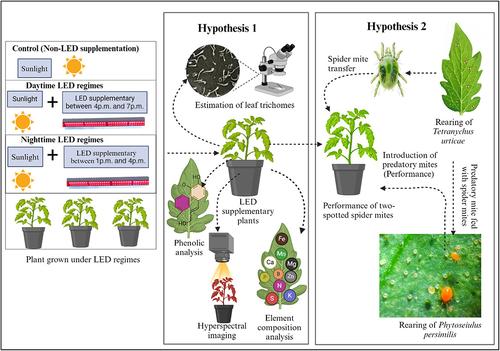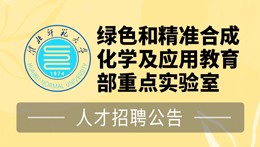当前位置:
X-MOL 学术
›
Pest Manag. Sci.
›
论文详情
Our official English website, www.x-mol.net, welcomes your
feedback! (Note: you will need to create a separate account there.)
Effects of timed LED regimes on tomato plant traits, performance of two‐spotted spider mites, and predatory mites (Phytoseiulus persimilis)
Pest Management Science ( IF 3.8 ) Pub Date : 2025-01-09 , DOI: 10.1002/ps.8630
Patrice Savi, Samantha Hall, Maria Hernandez, Anil Mantri, Daniel Kliebenstein, Christian Nansen
Pest Management Science ( IF 3.8 ) Pub Date : 2025-01-09 , DOI: 10.1002/ps.8630
Patrice Savi, Samantha Hall, Maria Hernandez, Anil Mantri, Daniel Kliebenstein, Christian Nansen

|
BACKGROUNDLight‐emitting diodes (LEDs) are being used in controlled environments to enhance crop production and pest management with most studies focusing on continuous treatments (applied throughout the entire daytime or nighttime period). Here, we tested the hypothesis that providing tomato plants with timed LED regimes (daily 3‐h doses of red, blue, or far‐red LED) during the day or at night may affect their traits (leaf reflectance indices, element composition, and phenolic profile), performance of two‐spotted spider mites (Tetranychus urticae ) (TSSM), and a species of predatory mite (Phytoseiulus persimilis) .RESULTSNighttime LED regimes significantly altered leaf element composition: red LED increased K levels, blue LED enhanced Mg levels, and far‐red LED enhanced Mn and Cu and reduced Zn levels. Among daytime LED regimes, blue LED reduced Zn level. Nighttime LED regimes significantly increased leaf glandular trichome densities (except far‐red regime) and reduced total phenolic content. Among a series of leaf reflectance indices, ARI and CRI increased significantly in response to nighttime red and blue regimes but decreased with far‐red LED regimes. Performance bioassays showed significantly lower TSSM populations on nighttime plants than on daytime and control plants. LED regimes did not affect predatory mites' population and their feeding capacity, except for blue daytime regime, which was reduced on mobile TSSM. These results suggest that timed LED regimes have potential to strategically manipulate plant‐prey–predator interactions.CONCLUSIONWe conclude that timed LED regimes can be crucial in designing integrated pest management strategies that promote both plant growth and effective biological control in controlled environments. © 2025 The Author(s). Pest Management Science published by John Wiley & Sons Ltd on behalf of Society of Chemical Industry.
中文翻译:

定时 LED 方案对番茄植株性状、双斑蜘蛛螨性能和捕食性螨 (Phytoseiulus persimilis) 的影响
背景发光二极管 (LED) 被用于受控环境,以提高作物生产和害虫管理,大多数研究侧重于连续处理(在整个白天或夜间应用)。在这里,我们检验了这样一个假设,即在白天或晚上为番茄植株提供定时 LED 方案(每天 3 小时剂量的红色、蓝色或远红 LED)可能会影响它们的性状(叶片反射指数、元素组成和酚类物质谱)、双斑蜘蛛螨 (Tetranychus urticae) (TSSM) 和一种捕食性螨虫 (Phytoseiulus persimilis) 的性能。结果线性 LED 机制显着改变了叶片元素的组成:红色 LED 增加了 K 水平,蓝色 LED 提高了 Mg 水平,远红 LED 增强了 Mn 和 Cu 并降低了 Zn 水平。在白天的 LED 状态中,蓝色 LED 降低了 Zn 水平。夜间 LED 状态显着增加了叶腺毛状体密度(远红状态除外)并降低了总酚含量。在一系列叶片反射指数中,ARI 和 CRI 响应夜间红色和蓝色状态显着增加,但随着远红 LED 状态而降低。性能生物测定显示,夜间植物的 TSSM 种群显著低于白天和对照植物。LED 机制不会影响捕食性螨虫的数量及其摄食能力,除了蓝色的白天机制,它在移动 TSSM 上有所减少。这些结果表明,定时 LED 机制有可能战略性地操纵植物-猎物-捕食者的相互作用。结论我们得出结论,定时 LED 制度对于设计综合害虫管理策略至关重要,这些策略可以在受控环境中促进植物生长和有效的生物控制。© 2025 作者。 由John Wiley & Sons Ltd代表化学工业协会出版的《害虫管理科学》。
更新日期:2025-01-09
中文翻译:

定时 LED 方案对番茄植株性状、双斑蜘蛛螨性能和捕食性螨 (Phytoseiulus persimilis) 的影响
背景发光二极管 (LED) 被用于受控环境,以提高作物生产和害虫管理,大多数研究侧重于连续处理(在整个白天或夜间应用)。在这里,我们检验了这样一个假设,即在白天或晚上为番茄植株提供定时 LED 方案(每天 3 小时剂量的红色、蓝色或远红 LED)可能会影响它们的性状(叶片反射指数、元素组成和酚类物质谱)、双斑蜘蛛螨 (Tetranychus urticae) (TSSM) 和一种捕食性螨虫 (Phytoseiulus persimilis) 的性能。结果线性 LED 机制显着改变了叶片元素的组成:红色 LED 增加了 K 水平,蓝色 LED 提高了 Mg 水平,远红 LED 增强了 Mn 和 Cu 并降低了 Zn 水平。在白天的 LED 状态中,蓝色 LED 降低了 Zn 水平。夜间 LED 状态显着增加了叶腺毛状体密度(远红状态除外)并降低了总酚含量。在一系列叶片反射指数中,ARI 和 CRI 响应夜间红色和蓝色状态显着增加,但随着远红 LED 状态而降低。性能生物测定显示,夜间植物的 TSSM 种群显著低于白天和对照植物。LED 机制不会影响捕食性螨虫的数量及其摄食能力,除了蓝色的白天机制,它在移动 TSSM 上有所减少。这些结果表明,定时 LED 机制有可能战略性地操纵植物-猎物-捕食者的相互作用。结论我们得出结论,定时 LED 制度对于设计综合害虫管理策略至关重要,这些策略可以在受控环境中促进植物生长和有效的生物控制。© 2025 作者。 由John Wiley & Sons Ltd代表化学工业协会出版的《害虫管理科学》。































 京公网安备 11010802027423号
京公网安备 11010802027423号